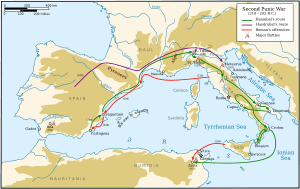Battle of the Guadalquivir (206 BC)
| Battle of Carteia | |||||||
|---|---|---|---|---|---|---|---|
| Part of the Second Punic War | |||||||
 Map of the Second Punic War | |||||||
| |||||||
| Belligerents | |||||||
|
|
| ||||||
| Commanders and leaders | |||||||
|
|
| ||||||
| Strength | |||||||
| Unknown |
6,000 soldiers (including 4,000 Celtiberians) 700 Cavalry | ||||||
The Battle of Carteia, also known by the modern name Battle of the Guadalquivir, was a battle of the Second Punic War that took place in 206 BC between the forces of Carthage and the Roman Republic. The name "Battle of the Guadalquivir" is anachronistic, since the river's name "el Guadalquivir", from the Arabic al-wadi al-kabir ("the great valley"), was not used until the Islamic conquest of Spain over nine hundred years after the battle. The Carthaginian forces were commanded by Hannón and the Romans by Gaius Lucius Marcius Séptimus. The battle resulted in a Roman victory.
Context
After the Carthaginian defeat at the Battle of Ilipa, the Turdetani flocked en masse to the Roman banner. Hasdrubal Gisco and Mago Barca were thereafter confined with their troops to Gadir where they were protected from a Roman assault. After the Revolt of Sucro and the Revolt of Indíbil and Mandonio, Publius Cornelius Scipio Africanus sent Gaius Lucius Marcius Séptimus with a small force uninhibited by baggage so as to augment their speed down the Guadalquivir River to the river mouth. There, the Romans encountered the Carthaginian general Hannón who was attempting to recruit a force of mercenaries for Mago Barca.
The Battle
Hannón had at his command 700 cavalry and 6,000 infantrymen, of whom 4,000 were Celtiberian warriors and the rest Africans. Gaius Lucius Marcius Séptimus attacked the Carthaginian force and surrounded them on a hill.
The mercenaries quickly reached an agreement with the Romans. Marcius further asked Hannón to hand over any prisoners that he had in his care. He further asked them for payment in order for them to be allowed to surrender the hill, whereafter they could reach an agreement.
Once the mercenaries had come down from the hill, Marcius gave his final demand for the mercenary forces to surrender their arms and return to their respective cities. Before long, indignation took hold in the Celtiberian ranks and they refused to surrender their arms. A second round of battle followed after this indignation. After brave resistance from the Carthaginian forces, over half their number were slaughtered, but a good deal were able to make an escape.
Consequences
The Carthaginian mercenaries that were able to escape, fled towards the army of Mago Barca who had arrived on the coast at the head of a fleet of 60 ships to pick up the surviving mercenaries. Carthaginian territory in the region was reduced to the city of Gadir after the fight. Mago Barca embarked the remainder of his army on boats in an attempt to take back Cartago Nova. Upon reaching the city, the Carthaginian army, which numbered only a few thousands, Barca's army anchored and disembarked. They laid siege to the city but were repulsed by Roman forces at the Battle of Cartagena.[1]
Mago Barca returned defeated to Gadir where he found that the local population had shut their gates to his army as they had begun negotiations with the Romans. Shortly thereafter, Mago abandoned the city and sailed to the Balearic Islands, spending the winter at Port Mahon. The following year, he sailed north to Italy where he hoped to instigate revolt amongst the Ligures people.[2][3]
See also
References
- ↑ Titus Livius, Ab urbe condita 28.36.7-9
- ↑ Prego de Lis, Augusto (2005). "El reino bárquida de Cartagena". Cartagena Histórica (13): 5–19. ISSN 1696-991X.
- ↑ Revista Cartagena Historica, La conquista Bárcida
